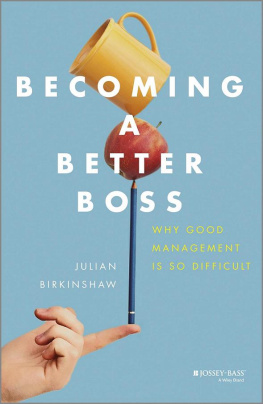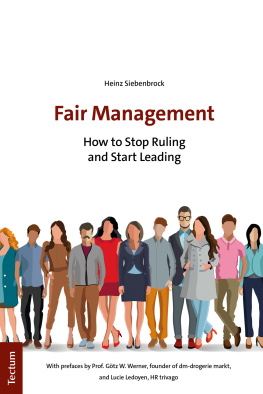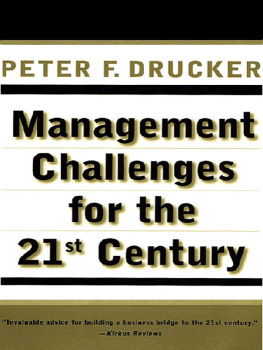Table of Contents
This book is dedicated to Laura, Ross, Duncan, and Lisa
Preface
This book tells you what management is, why it is important, and how you can generate competitive advantage for your company by taking it seriously.
You might expect there to be a lot of books on this subject, given the enormous numbers of people who are managers, and the poor quality of management that exists in many organizations. But the reality is that very few management writers write specifically about the nature of Management. A few lonely voicesmost notably Peter Drucker and Henry Mintzberghave continued to remind us of its importance, but most writers have preferred to focus on more alluring themes, such as leadership, change and strategy.
There are a couple of prejudices about the practice of management that help to explain why it has struggled for attention. The first prejudice suggests that management is simple, timeless and unchanging. People have been managing others since the time of the pyramids, it is argued, and the basic tasks of coordinating and controlling havent changed since then. So is there really anything new to learn? Yes, in fact, there is. While the functions of management have changed very little over the years (in terms of what needs to be done), the methods of management (in terms of how it gets done) have changed dramatically. And the technological and social changes afoot in the business world today will result in even greater changes in the years ahead.
The second prejudice suggests that what organizations really need is leaders, not managers. Leadership is probably the biggest single category of business books today, and every business school offers courses to help you improve your leadership skills. Management now sits firmly in the shadow of leadership, often viewed as a necessary but rather tedious activity.
But its not obvious that this recent focus on leadership has really helped to improve the agility or competitiveness of our business organizations. Indeed, if there is a problem today in the world of business, it is that companies dont implement their grand plans as effectively as they should. There is a gap between our goals and our ability to achieve them. And I believe it is the job of management, the discipline of getting work done through others, to fill that gap.
Management and leadership, other words, are both equally important. They are two horses pulling the same cart. We need to pay much greater attention to management to put it back on an equal footing with leadership.
My own research on management began five years ago, when I first started collaborating with Gary Hamel, a Visiting Professor at the London Business School and the founder of Strategos, a Chicago-based consulting firm. We shared an interest in helping companies to become more resilient and more entrepreneurial, and we quickly came to the view that the biggest single blocker to change was the antiquated approach to management used by most large companies. The concept of the Management Innovation Lab (MLab) was born, with support from London Business School, UBS, the David and Elaine Potter Charitable Foundation, the CIPD and AIM Research.
We decided that the mission of MLab was to Accelerate the evolution of management. A lot of people scratched their heads when we explained this to them. How can you innovate management? What is management anyway? Surely you mean leadership, not management? All the old prejudices came out, but we stuck to our guns. We began working with a few progressive companies to help them dream up and try out innovative management methods. And we built relationships with management innovators in dozens of companies around the worldpeople who had put their own experimental approaches to management in place, and wanted some reassurance that they were on the right track.
Two years ago, I published Giant Steps in Management with my colleague Michael Mol. It was an attempt to make sense of the history of management innovationhow 50 key innovations including Total Quality Management, Brand Management and Activity Based Costing had influenced the development of management as a field. We were interested in understanding how these individual innovations had come about, and also how they had collectively brought about a transformation (over a 150-year period) in the nature of management work.
In this book, I turn my attention to the future. Rather than look at individual management innovations, my focus is on what I have come to call the companys Management Modelthe conscious choices made by its top executives to define how work gets done. I believe it is not sufficient simply to look for ways of improving individual components of management, such as enhancing the compensation system, or making the planning system more efficient. Rather, the challenge is to think about how these discrete choices fit together, and to figure out how your Management Model, as a whole, supports and enriches your companys strategy.
This book provides you with the frameworks and tools you need to reinvent management in your company. It will describe the full range of methods companies use to coordinate activities, make decisions, set objectives, and motivate people. And it will help you to make smarter choicesin the context of your own particular circumstancesfor getting work done.
Acknowledgements
This book is the culmination of more than five years work, and it has involved interviews with many hundreds of executives and conversations with many dozens of colleagues. While it will not be possible to acknowledge everyone who helped me put the book together, I would like at least to acknowledge my main sources of inspiration and insight.
It was Gary Hamel who got me started on the journey that led to this book, when we first started talking about the need for management innovation back in 2004. I helped Gary to create the Management Innovation Lab (MLab), and over the years it has become an important vehicle for trying out and focusing our ideas. Many of the ideas in this book came out of conversations with Gary, for which I am truly grateful. Thanks also to the other individuals involved in MLab: Jules Goddard, Jeremy Clarke, Alan Matcham, Lisa Valikangas and Stuart Crainer. MLab was sponsored by UBS, the David and Elaine Potter Charitable Foundation, the CIPD and the Advanced Institute of Management Research.
I am indebted to all my co-authors who have helped me to get my ideas into shape and ready for publication in academic and managerial journals. Some of the papers we have written together are explicitly referred to in this book; others have influenced this book more indirectly. So thanks to: Tina Ambos, Cyril Bouquet, Andrew Campbell, Cris Gibson, Jules Goddard, Huw Jenkins, Morten Hansen, Suzanne Heywood, Susan Hill and Michael Mol.
I interviewed perhaps two hundred executives in preparation for writing this book. I have not kept good records of all these interviews, but I would like to acknowledge the following individuals who all offered useful examples or insights: Francesca Barnes, Tod Bedilion, Ed Bevan, Tim Brooks, Randy Chase, Jack Hughes, Lianne Eden, Hari Hariharan, Modestas Gelbudas, Jeff Hollender, Larry Huston, Huw Jenkins, P.V. Kannan, Terri Kelley, Graham Kill, Lars Kolind, Srinivas Koushik, John Mackey, Dena McCallum, Jim McKeown, Michael Molinaro, Sunil Jayantha Narawathne, Vineet Nayar, Hillary Neumayr, Jeremy Palmer, John Perkins, David Potter, Robyn Pratt, Hema Ravichandrar, Bruce Rayner, Peter Robbins, Eric Schmidt, Art Schneiderman, Ross Smith, Toni Stadelmann, Henry Stewart, Claudius Sutter, Reto Wey, Mike Wing and David Yuan.










